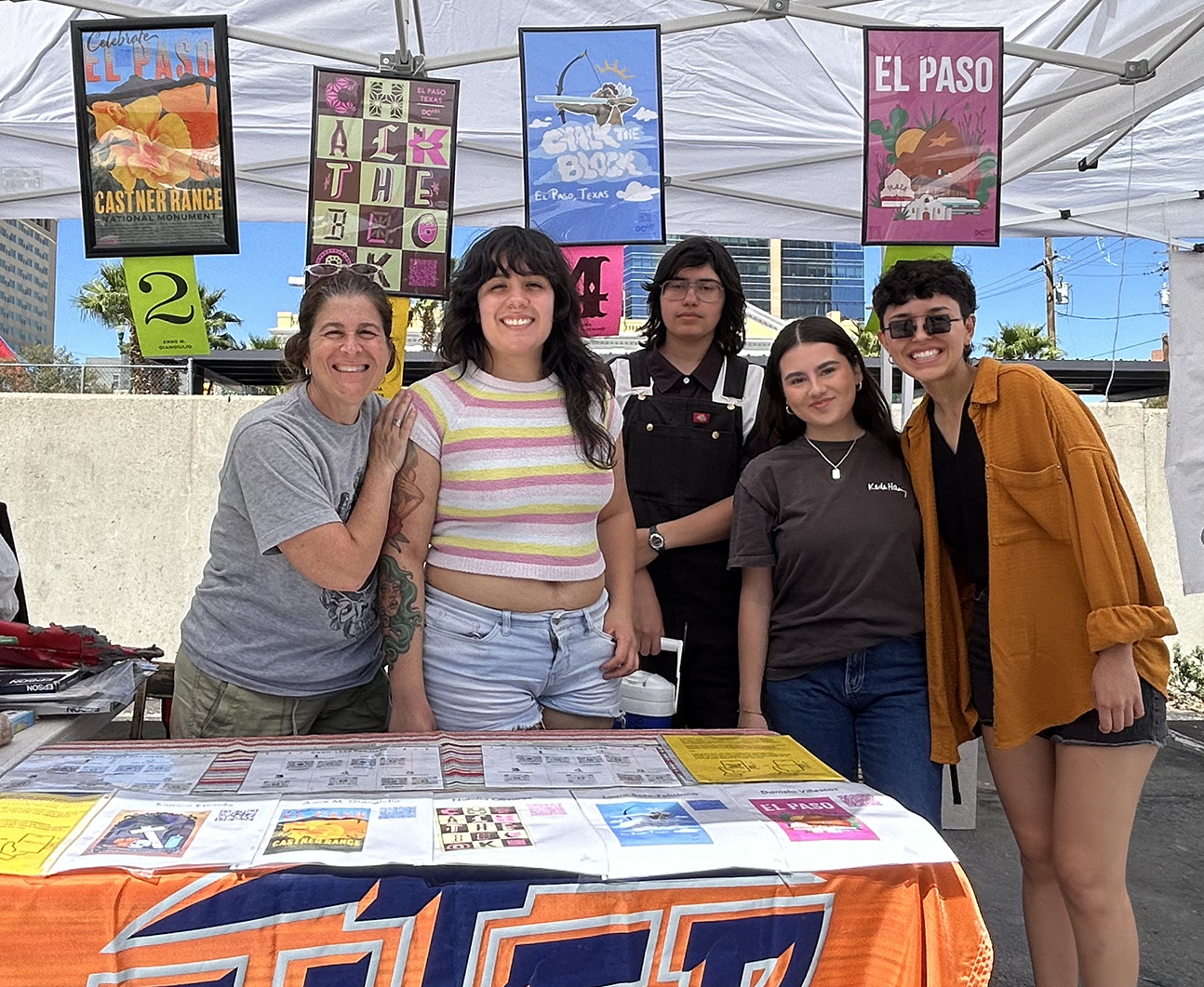
UTEP Graphic Design Students Embrace Modern Technologies
If you strolled this year’s Chalk the Block in Downtown El Paso, you may have noticed a booth selling posters designed by UTEP’s very own graphic design students. From afar, they appeared to be intricately and thoughtfully designed pieces, and up close, they are even more unique. Using an augmented reality application, students are bringing their works to life through animation.

Katrina Estrada, a senior illustration major minoring in graphic design, is one such student who is utilizing modern technologies in their design work. An illustrator at heart, Estrada takes a multifaceted approach to her work and is grateful to be able to use these technologies in her projects.
“I always start with hand drawings,” Estrada said. “At the beginning stages, you have to think of whatever is in your head and put it on a piece of paper. And then gradually, you [use] the computer more and more.”
One tool Estrada has learned is augmented reality, which works by using technology to superimpose images and videos into a person’s field of vision. In the poster sold at Chalk the Block, Estrada brought her artwork to life using an application called Artivive, which allowed her to upload a file of her poster and then superimpose the animated version of her poster.
Through the Artivive app, users can point their phone at the still image presented on the poster and see the animation designed by Estrada. Students also included a QR code that takes viewers to a website where they can also view the animation.
Estrada felt challenged by using these new technologies, pushing herself to think outside of the box to ensure her animation worked.
“I had to make an animation that was [saved in] a separate file, and then at the end, combine them and make them work together so that when you put your phone over the image, it moves and plays the animation,” Estrada said.
Another emerging field that graphic design students learn about is user experience (UX) and user interface (UI) design. UX design addresses how individuals experience and use a website or app, while UI design takes into consideration the way in which humans interact with computer systems. These two processes help to make tasks like browsing a webpage or using an app a breeze.
“You have to think about the person using [the website or app] because with UX and UI, you are designing for other people,” said Estrada, who is currently enrolled in her first UX course. “You have to really put yourself in their perspective, and what they would want out of your product or application. Before [this class], my classes were based on working with one client – it’s just one person or a team of people, and you’re only meeting their needs, whereas with UX/UI, you’re thinking of multiple people. What’s the best way for them to use it?”
With the evolution of technology, the field of graphic design can change overnight. New tools, programs and an ever-changing digital landscape means that graphic designers, from students and professors to professionals working in the field, must stay on their toes. Anne M. Giangiulio, an associate professor in the Department of Art, is at the forefront of ensuring graphic design students are able to explore emerging technologies.
“When I was hired back in 2004, we didn’t even have web design in the curriculum,” Giangiulio said. “All the work created in classes was for print, not for screens. So that’s the first and foremost thing that I [introduced].”
To incorporate new technologies and methodologies more quickly into the curriculum, faculty may first introduce the topic as a special topics class. Based on the response to that class, the University can then decide whether to incorporate the topic into the course catalog. When UTEP first offered web design as a special topics course, it was immediately success.
“The class was bursting at the seams,” Giangiulio said. “It was clear our students wanted to learn it.”
Giangiulio added that this skill can improve students’ chances in a competitive job market. “We owe that to them,” she said. “They need to hit the ground running once they graduate, so just being aware of what the market is demanding is really the key to keeping our curriculum fresh and relevant.”
This coursework also helps ensure students gain real-world experience while still in school, with a community engagement spin. Through the graphic design program, students design for local nonprofits, human rights organizations and major events like Chalk the Block.
“We work with a lot of nonprofits and causes that really deserve great design but can’t necessarily afford it,” Giangiulio said. “So, we’ve really honed in on things like that around the community. For example, we created the logo for the Rescue Mission as well as their Hallelujah BBQ restaurant. We’re working with another UTEP colleague, Yok-Fong Paat in the College of Health Sciences, on a grant with [the Department of] Homeland Security on preventing violence and terrorism by spreading kindness. These are really great projects for students to become engaged with.”
To learn more about UTEP’s art program, including a concentration in graphic design, please visit: https://www.utep.edu/programs/undergraduate/art.html
Last Updated on November 15, 2023 at 12:00 AM | Originally published November 15, 2023
By Julia Hettiger UTEP Marketing and Communications
